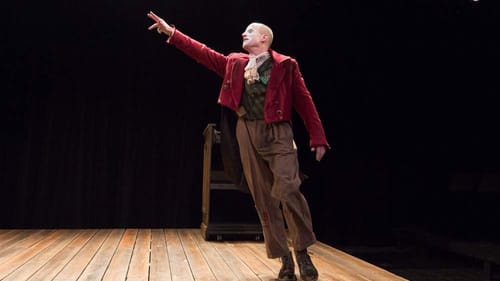Stay in the Loop
BSR publishes on a weekly schedule, with an email newsletter every Wednesday and Thursday morning. There’s no paywall, and subscribing is always free.
A Dickens of a show
The Lantern presents Charles Dickens’s ‘A Christmas Carol’

As December 25 creeps closer, you might think another Christmas Carol is the last thing you need to see. Well, dear readers, think again. Lantern Theater Company’s one-person adaptation — devised by actor Anthony Lawton, set and lighting maven Thom Weaver, and sound designer Christopher Colucci — blows the dust off the familiar Dickens tale, revealing fresh, invigorating layers of meaning.
A virtuosic solo performer, Lawton has turned monology into a cottage industry. He’s particularly known for a successful series of shows adapted from the works of C.S. Lewis. He brings the same level of verbal wit and engaging, uncomplicated storytelling to A Christmas Carol. He marries the messages of Dickens’s holiday fable — redemption, renewal, and fellowship — to a narrative structure that simultaneously upholds and subverts our expectations of this familiar material.
Pour one out for Marley
Lawton’s unnamed narrator arrives onstage warbling “We Need a Little Christmas” from Jerry Herman’s Mame. He resembles a tramp clown in white makeup, wearing costume designer Kierceton Keller's tattered morning coat and patched pants. He opens not with Dickens’s famous first sentence — “Marley was dead, to begin with” — but with the tipple of a flask. Clearly, this is not your grandfather’s Christmas Carol.
It’s not your grandchild’s Christmas Carol either. Although this version can and should be enjoyed by the young people in your life, Lawton doesn’t pander exclusively to the rosier elements of the story. He isn’t afraid to jump headlong into the darker, thornier matters at hand — nor is Weaver afraid to plunge the theater into full darkness, in a series of chilling lighting cues.
The battle for a soul
When we do meet Ebenezer Scrooge, he isn’t the crusty, cantankerous figure familiar from other popular adaptations. Lawton describes him as “a kind of cannibal who ate people alive,” a portrait that becomes vivid in his interactions with charity collectors, street urchins, and of course his kindhearted clerk, Bob Cratchit. This sets up a battle for a soul that needs saving, and for once, the outcome doesn’t seem blissfully clear from the start.
Scrooge’s growth takes on a fresh resonance in this light, and his flashbacks to happier Christmas days with the Ghost of Christmas Past are newly moving. When Scrooge and his sister Fan box-step in a cold classroom to “The Holly and the Ivy,” you see two mistreated children clinging to each other for comfort. Colucci’s sound design repeats this carol throughout the performance, and it takes on a haunting dimension.

Scrooge’s first blush of love with former fiancée Belle holds the promise of a long, contented life. Their eventual separation caused my eyes to well — and Belle’s cold assertion that a golden idol has replaced her in Scrooge’s estimation shows that Lawton won’t shy away from the novel’s strong anticapitalist ethos.
Lawton’s narration effectively moves back and forth in time, incorporating current and familiar references. He compares the Ghost of Christmas Present’s stature to “two Shaqs and a Manute Bol,” effortlessly producing a towering image. He references Reading Terminal Market, Isgro’s, and DiBruno Brothers in ways that don’t feel like civic pandering. He quotes Hamlet to demonstrate the depths of Scrooge’s depravity — upon hearing that “there are more things in Heaven and Earth than are dreamt of in your philosophy,” his response would center on the denial of an afterlife and the derision of philosophy as a fake major.
A reprieve from pageantry
As the action moves through the spirit realm — with its familiar detours to the Cratchits’ meager Christmas feast and Scrooge’s austere funeral — we sense Scrooge’s awakening to humanity in ways that feel authentic and immediate. The sweat from Lawton’s physically limber performance causes some of his heavily applied makeup to fade. Whether or not this is intentional, it serves as a good metaphor for Scrooge’s journey: He gradually sheds the mask he’s constructed to keep himself cold, hard, and alone. He rejoins the human race with a full and open heart.
Staged versions of A Christmas Carol often center around pageantry: holiday songs belted at full voice, choruses of children and community members, ornate costumes and hulking sets. The version created by Lawton, Colucci, and Weaver eschews that all. It privileges simple storytelling, with a clear intent and a strong message, in the hands of a first-rate performer. I have to imagine that Dickens — one of the greatest plot-weavers of all time — would be proud.
Memo to Lantern: Make this a holiday tradition.
What, When, Where
Charles Dickens’s A Christmas Carol. Adapted by Anthony Lawton, in collaboration with Christopher Colucci and Thom Weaver, from the novel by Charles Dickens. Lantern Theater Company. Through January 6, 2019, at the URBN Center Black Box, 3401 Filbert Street, Philadelphia. (215) 829-0395 or lanterntheater.org.
Sign up for our newsletter
All of the week's new articles, all in one place. Sign up for the free weekly BSR newsletters, and don't miss a conversation.

 Cameron Kelsall
Cameron Kelsall